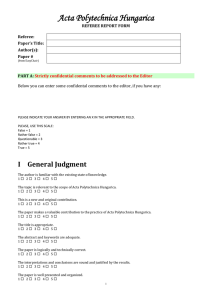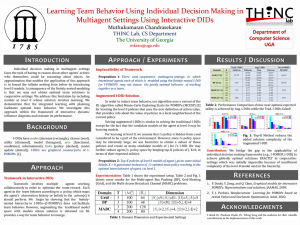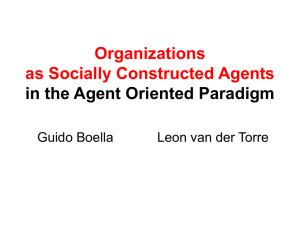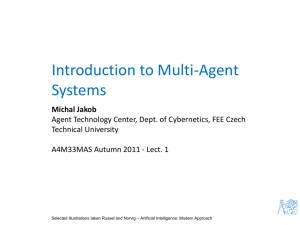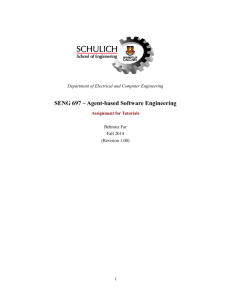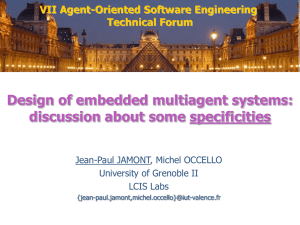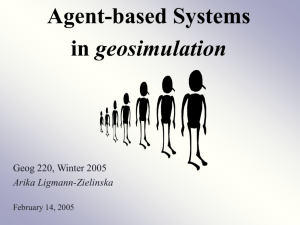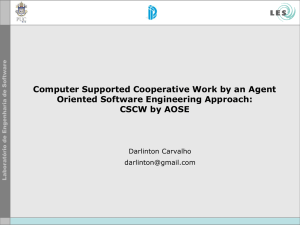A Preliminary Study of the Application of the P-
advertisement
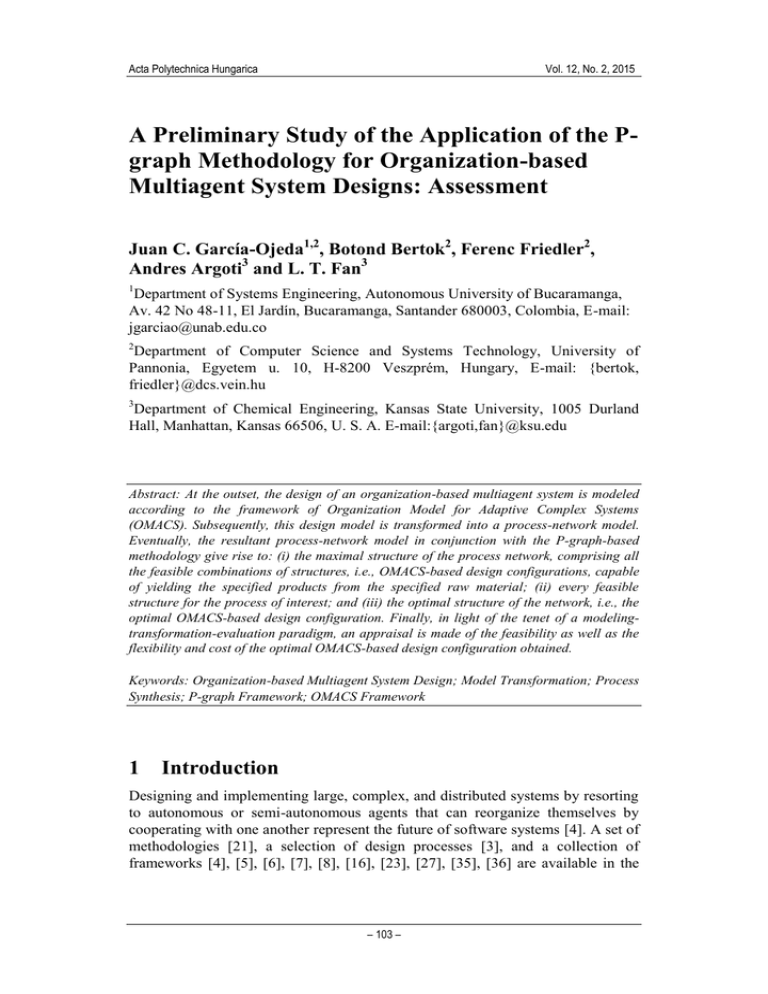
Acta Polytechnica Hungarica
Vol. 12, No. 2, 2015
A Preliminary Study of the Application of the Pgraph Methodology for Organization-based
Multiagent System Designs: Assessment
Juan C. García-Ojeda1,2, Botond Bertok2, Ferenc Friedler2,
Andres Argoti3 and L. T. Fan3
1
Department of Systems Engineering, Autonomous University of Bucaramanga,
Av. 42 No 48-11, El Jardín, Bucaramanga, Santander 680003, Colombia, E-mail:
jgarciao@unab.edu.co
2
Department of Computer Science and Systems Technology, University of
Pannonia, Egyetem u. 10, H-8200 Veszprém, Hungary, E-mail: {bertok,
friedler}@dcs.vein.hu
3
Department of Chemical Engineering, Kansas State University, 1005 Durland
Hall, Manhattan, Kansas 66506, U. S. A. E-mail:{argoti,fan}@ksu.edu
Abstract: At the outset, the design of an organization-based multiagent system is modeled
according to the framework of Organization Model for Adaptive Complex Systems
(OMACS). Subsequently, this design model is transformed into a process-network model.
Eventually, the resultant process-network model in conjunction with the P-graph-based
methodology give rise to: (i) the maximal structure of the process network, comprising all
the feasible combinations of structures, i.e., OMACS-based design configurations, capable
of yielding the specified products from the specified raw material; (ii) every feasible
structure for the process of interest; and (iii) the optimal structure of the network, i.e., the
optimal OMACS-based design configuration. Finally, in light of the tenet of a modelingtransformation-evaluation paradigm, an appraisal is made of the feasibility as well as the
flexibility and cost of the optimal OMACS-based design configuration obtained.
Keywords: Organization-based Multiagent System Design; Model Transformation; Process
Synthesis; P-graph Framework; OMACS Framework
1
Introduction
Designing and implementing large, complex, and distributed systems by resorting
to autonomous or semi-autonomous agents that can reorganize themselves by
cooperating with one another represent the future of software systems [4]. A set of
methodologies [21], a selection of design processes [3], and a collection of
frameworks [4], [5], [6], [7], [8], [16], [23], [27], [35], [36] are available in the
– 103 –
J. C García-Ojeda et al.
A Preliminary Study of the Application of the P-graph Methodology for
Organization-based Multiagent System Designs: Assessment
literature to provide the basis for constructing sophisticated autonomous
multiagent organizations. Moreover, a set of metrics and methods have been
suggested with the intention of providing useful information about key properties
(e.g., complexity, flexibility, self-organized, performance, scalability, and cost) of
these multiagent organizations [24], [26], [31], [33].
The above-mentioned methodologies, processes, frameworks, and procedures,
nevertheless, do not offer techniques for identifying the number of feasible
configurations1 that can be synthesized, or designed, from a set of heterogeneous
agents. This is an important issue when designing a multiagent system because of
the nature of the environments where it operates (dynamic, continuous, and
partially accessible) [29]. The multiagent system must be adaptive (selforganized) to adjust its behavior to cope with the dynamic appearance and
disappearance of goals (tasks), their given guidelines, and the overall goal of the
multiagent system [29], [30]. To address such an issue, i.e., identifying feasible
agent´s configurations, we propose a novel approach based upon previous work on
organization-based multiagent systems [4] and the P-graph methodology [10].
The current contribution describes the deployment of the P-graph methodology for
synthesizing organization-based multiagent systems based upon the OMACS
framework. The remainder of the current contribution comprises: an outline of the
OMACS framework (Section 2); a brief description of the P-graph methodology
(Section 3); the motivational example for undertaking the work (Section 4); a
procedure for transforming an organization-based multiagent system design into a
process-synthesis problem (Section 5); a description of the mathematical
programming model for synthesizing organization-based multiagent systems
(Section 6); the preliminary results of the proposed approach (Section 7); and
finally, the conclusions as well as the proposed future work (Section 8).
2
The Framework of Organization Model for
Adaptive Computational Systems: OMACS
The Framework of Organization Model for Adaptive Computational Systems
(hereafter, OMACS) defines the entities in standard multiagent systems and their
relationship as a tuple OOMACS = ⟨GOMACS, ROMACS, AOMACS, COMACS, Φ, POMACS, Σ,
oaf, achieves, capable, requires, possesses, potential⟩, and it is also represented
via an UML2-based organizational meta-model (see Figure 1) [4]. These are
briefly described in what follows.
1
2
These feasible configurations may be seen as agent´s organizations or agents’ teams
[4].
Unified Modeling Language (UML) is a standardized general-purpose modeling
language in the field of object-oriented software engineering.
– 104 –
Acta Polytechnica Hungarica
Vol. 12, No. 2, 2015
The organization, OOMACS, is composed of four entities including GOMACS, ROMACS,
AOMACS, and COMACS. GOMACS defines the goals of the organization (i.e., overall
functions of the organization); ROMACS defines a set of roles (i.e., positions within
an organization whose behavior is expected to achieve a particular goal or set of
goals). AOMACS is a set of agents, which can be either human or artificial (hardware
or software) entities that perceive their environment (Σ – domain model) and can
perform actions upon it. In order to perceive and to act, the agents possess a set of
capabilities (COMACS), which define the percepts/actions at their disposal.
Capabilities can be soft (i.e., algorithms or plans) or hard (i.e., hardware related
actions). POMACS formally specifies rules that describe how OOMACS may or may not
behave in particular situations.
Figure 1
OMACS Meta-model [4]
In addition, OMACS defines a set of functions – achieves, requires, possesses
capable, potential, oaf, and ϕ – to capture the different relations among the
entities. achieves, a function whose arguments are a goal in GOMACS as well as a
role in ROMACS that generates an output which is a positive real number greater
than or equal to 0 and less than or equal to 1 (achieves, ROMACS x GOMACS → [0,1],
defines the extent of achievement of a goal by a role); possesses, a function with
an agent in AOMACS and a capability in COMACS as inputs yields a positive real
number in the range of [0,1] (possesses, AOMACS x COMACS → [0,1], defines the
quality of an agent´s capability); requires, a function that assumes a role in ROMACS,
thereby yielding a set of capabilities required to play that role (requires, ROMACS →
ρ(COMACS), defines the set of capabilities required to play a role 3); capable, a
function whose inputs are an agent in AOMACS and a role in ROMACS and generates an
3
ρ denotes power set.
– 105 –
J. C García-Ojeda et al.
A Preliminary Study of the Application of the P-graph Methodology for
Organization-based Multiagent System Designs: Assessment
output, which is a positive real number greater than or equal to 0 and less than or
equal to 1 (capable, AOMACS x ROMACS → [0,1], defines how well an agent can play
a role), thus giving rise to
0
𝑖𝑓
∏
𝑝𝑜𝑠𝑠𝑒𝑠𝑠𝑒𝑠(𝑎, 𝑐) = 0
(1)
𝑐 ∈ 𝑟𝑒𝑞𝑢𝑖𝑟𝑒𝑠(𝑟)
𝑐𝑎𝑝𝑎𝑏𝑙𝑒(𝑎, 𝑟) =
∑𝑐 ∈ 𝑟𝑒𝑞𝑢𝑖𝑟𝑒𝑠(𝑟) 𝑝𝑜𝑠𝑠𝑒𝑠𝑠𝑒𝑠(𝑎, 𝑐)
|𝑟𝑒𝑞𝑢𝑖𝑟𝑒𝑠(𝑟)|
{
𝑒𝑙𝑠𝑒𝑤ℎ𝑒𝑟𝑒;
potential, a function with an agent in AOMACS, a role in ROMACS, and a goal in
GOMACS as inputs yields a positive real number in the range of [0,1], thus yielding
potential(a, r, g) = achieves(r, g) * capable(a, r)
(2)
(potential, AOMACS x ROMACS x GOMACS → [0,1], defines how well an agent can play
a role to achieve a goal), and assignment set, ϕ, the set of agent-role-goal tuples
<a, r, g>, indicating that agent a AOMACS has been assigned to play role r
ROMACS in order to achieve goal g GOMACS (ϕ is a subset of all the potential
assignments of agents to play roles to achieve goals). Finally, the selection of ϕ
from the set of potential assignments is defined by the organization’s
reorganization function, oaf, that assumes a set of assignments in ϕ, thereby
yielding a positive real number in the range of [0,∞] (oaf, ρ(ϕ) → [0,∞], defines
the quality of a proposed set of assignments, i.e., oaf computes the goodness of the
organization based on ϕ), thus resulting in
𝑜𝑎𝑓 =
∑
𝑝𝑜𝑡𝑒𝑛𝑡𝑖𝑎𝑙(𝑎𝑖 , 𝑟𝑗 , 𝑔𝑗 ).
(3)
<𝑎𝑖 ,𝑟𝑗 ,𝑔𝑗 >∈𝜙𝑂𝑀𝐴𝐶𝑆
3
Process Network Synthesis
In a process system, raw materials are consumed through various transformations
(e.g., chemical, physical, and biological) to desired products. Vessels where these
transformations take place are called operating units of the process. A given set of
operating units with likely interconnections can be portrayed as a network.
The desired products can be also manufactured via some sub-networks of the
above-mentioned network. Thus, a given network may give rise to a variety of
processes, or process networks, producing the desired products, and each of such
process networks corresponds to a sub-network, that can be considered regarded
as its structure. Energy and raw material consumption strongly depend on the
selection of a process structure; thus, the optimal design of such a process
structure, i.e., the process network synthesis (PNS), or process synthesis in short,
has both environmental and economic implications [14].
– 106 –
Acta Polytechnica Hungarica
Vol. 12, No. 2, 2015
A number of methods has been developed for process synthesis [28]. These
methods can be classified according to whether they are based on heuristics or
algorithms, i.e., mathematical programming approaches. The majority, if not all,
of these methods, however, may not be sufficiently effective for PNS of a realistic
or industrial scale, process because of its combinatorial complexity arising from
the involvement of a large number of interconnected loops [14]. To cope with this,
an innovative approach based on P-graphs (process graphs), which are unique,
mathematically rigorous bipartite graphs, has been proposed to facilitate the
process network synthesis [10]. The P-graphs are capable of capturing not only the
syntactic but also semantic contents of a process network. Subsequently, an axiom
system underlying the P-graph framework is constructed to define the
combinatorial feasible process-network structures. The analysis and optimization
of properties of such structures are performed by a set of efficient combinatorial
algorithms: MSG [9], SSG [9], and ABB [13].
3.1
Process Graph (P-graph)
The mathematical definition of a P-graph and a process structure represented by it
are elaborated below [10].
Finite set M, containing materials, and finite set O, containing operating units, are
given such that
0 ρ(M) x ρ(M)
(4)
Thus, a P-graph can be defined to be a pair, (M,O), as follows:
The vertices of the graph are the elements of
V=MxO
(5)
Those belonging to set M are of the M-type vertices, and those belonging to set O
are of O-type vertices. The arcs of the graph are the elements of
A = A 1 A2
(6)
A1 = {(X,Y) | Y = (α,β) ϵ O and X ϵ α}
(7)
where
and
A2 = {(Y,X) | Y = (α,β) ϵ O and X ϵ β }
(8)
In these expressions, X designates an M-type vertex; Y, an O-type vertex; α a set
of M-type vertices from which arcs are directed into the O-type vertices; and, β a
set of M-type vertices to which arcs are directed out of the O-type vertices.
For illustration let M be a set of materials, M={A,B,C,D,E,F}, and O be a set of
operating units given by O={({B,A},{A}),({D,E},{B,C}),({F},{A,C}), ({F},{A,C})}.
It is not difficult to validate that sets M and O satisfies constraint (1), i.e., (M,O) is
a P-graph, as depicted in Figure 2.
– 107 –
J. C García-Ojeda et al.
3.2
A Preliminary Study of the Application of the P-graph Methodology for
Organization-based Multiagent System Designs: Assessment
Solution Structures
The materials and operating units in a feasible process structure must always
conform to certain combinatorial properties. For example, a structure containing
no linkage between a raw material and a final product is unlikely to represent any
practical process. Hence, it is of vital importance to identify the general
combinatorial properties to which a structure must conform. More important, the
properties identified should be satisfied by the structure of any feasible solution of
the synthesis problem. In other words, those and only those structures satisfying
these properties can be feasible structures of a process: no other structures or
constraints need to be considered in synthesizing the process.
A set of axioms has been constructed to express necessary and sufficient
combinatorial properties to which a feasible process structure should conform.
Next, each axiom is stated: (S1) Every final product is represented in the graph;
(S2) A vertex of the M-type has no input if and only if it represents a raw material;
(S3) Every vertex of the O-type represents an operating unit defined in the
synthesis problem; (S4) Every vertex of the O-type has at least one path leading to
a vertex of the M-type representing a final product; and, (S5) If a vertex of the Mtype belongs to the graph, it must be an input to or output from at least one vertex
of the O-type in the graph.
Figure 2
P-graph (M,O) where A,B,C,D,E, and F are materials, and 1,2, and 3 are the operating units:
represents raw materials or input elements of the whole process;
symbolizes intermediate-materials
or elements, emerging between the operating units; and
represents products or outputs of the entire
process
If a P-graph of a given synthesis problem, (P,R,O)4, satisfies theses axioms, it is
defined to be a solution-structure of the problem.
4
Where P M is the set of product, R M is the set of raw materials, and O the set of
operating units.
– 108 –
Acta Polytechnica Hungarica
3.3
Vol. 12, No. 2, 2015
Algorithms MSG, SSG, and ABB
Both the P-graph representation of a process network and the set of five axioms
for solution structures, i.e., combinatorial feasible networks, render it possible to
fashion the three mathematically rigorous algorithms: MSG, SSG, and ABB. The
algorithm MSG (Maximal-Structure Generation) generates the maximal structure
(super-structure) of a process synthesis network. Also, the algorithm SSG
(Solution-Structure Generation) generates the set of feasible process structures
from the maximal structure, which leads to the algorithm ABB (Accelerated
Branch and Bound) for computing the n-best optimal solution structure [9], [10],
[11], [12], [13].
4
Motivational Example: Cooperative Robotic Search
Team System
To demonstrate the application of the P-graph framework for assessing the design
of OMACS-based multiagent systems, a survey is given of a simplified
Cooperative Robotic Search Team5 (CRST) system [20], [33]. Essentially, we are
to design a team of robots whose goal is to search for different areas of a given
location on a map. The team should be able to search any area of the given
location even when faced with failures of individual robots or specific capabilities
of those robots. This implies that the team must be able to: (1) assign areas based
on individual team member´s reliability; (2) recognize when a robot is unable to
perform adequately its duties; and (3) reorganize the team to allow it to achieve its
goals in spite of individual failures.
4.1
Overview of CRST Organization
For illustration, it is presumed that four goals be achieved by the CRST. In other
words, G = {g1, g2, g3, g4} where gi for 1 i 4 signifies “search area i.” In the
CRST, two roles are identified, i.e., R = {r1,r2} where r1 and r2 represent the
Searcher and Patroller roles, respectively. In particular, role r1requires the Sonar,
Movement, and GPS capabilities for achieving goals g1, g2, g3, and g4. Likewise,
role r2 requires the Movement, GPS, and Range Finder capabilities for achieving
the same goals as those of role r1. Moreover, for each goal, gj, an achieve value is
assigned. This achieve value defines the extent of achievement of a goal by a role.
Both, the requires and achieves relations can be formally stated as:
requires = {( r1,{c1, c2, c3}),( r2,{c2, c3, c4})} and achieves = {(r1, g1, 0.2), (r1, g2,
0.4), (r1, g3, 0.8), (r1, g4, 1.0), (r2, g1, 1.0), (r2, g2, 0.7), (r2, g3, 0.4), (r2, g4, 0.1)}.
5
Although the CRST presented in this paper has been simplified (due to space
constraint), it is still interesting enough to illustrate our work.
– 109 –
J. C García-Ojeda et al.
A Preliminary Study of the Application of the P-graph Methodology for
Organization-based Multiagent System Designs: Assessment
Also, four capabilities are specified. They are Sonar (c1), Movement (c2), GPS
(c3), and Range Finder (c4). c1 captures information about all objects around agent
ai (in a 360° view). c2 allows agent ai to move in any direction, north, south, east,
or west (up, down, left, or right). c3 provides the ability to read the absolute
position of agent ai in the environment. Finally, c4 renders it possible for agent ai
to measure the distance of the closest object directly in front of it.
In addition, three different agents are modeled; they are a1, a2, and a3.
Specifically, agent a1 possesses capabilities c1, c2, c3, and c4 while both agents a2
and a3 possess capabilities c2, c3, and c4. The possesses relationship is formulated
as follows: possesses = {(a1,c1,0.3), (a1,c2,0.5), (a1,c3,0.3), (a1,c4,0.3), (a2,c2,0.7),
(a2,c3,0.5), (a2,c4,0.7), (a3,c2,0.4), (a3,c3,0.9), (a3,c4,0.2)}.
Additionally, the cost of each individual agent a1, a2, and a3 is $850, $900, and
$950, respectively (see Figure 3).
Figure 3
Overview of the CRST Organization. The boxes at the top of the diagram represent agents identified
by their types, circles represent the roles, pentagons represent capabilities, and squares are system’s
goals. The arrows between the entities represent functions/relations achieves, requires, and possesses
5
Algorithm OMACStoPNS
Algorithm OMACStoPNS comprises two mayor parts, the initialization and the
construction parts. The initialization part (statements st1, st2, st3, and loop lp1)
specifies the sets of available raw materials and desired products to be
manufactured as well as their parameters. The construction part (loop lp3)
specifies the set of candidates operating units as well as their parameters (see
Figure 3).
– 110 –
Acta Polytechnica Hungarica
Vol. 12, No. 2, 2015
𝐢𝐧𝐩𝐮𝐭: 𝐺𝑂𝑀𝐴𝐶𝑆 , 𝐴𝑂𝑀𝐴𝐶𝑆 , 𝑅𝑂𝑀𝐴𝐶𝑆 , 𝑎𝑐ℎ𝑖𝑒𝑣𝑒𝑠, 𝑟𝑒𝑞𝑢𝑖𝑟𝑒𝑠, 𝑝𝑜𝑠𝑠𝑒𝑠𝑠𝑒𝑠
𝐜𝐨𝐦𝐦𝐞𝐧𝐭: 𝐺𝑂𝑀𝐴𝐶𝑆 defines the goals of the organizations, 𝑅𝑂𝑀𝐴𝐶𝑆 defines a set of roles, 𝐴𝑂𝑀𝐴𝐶𝑆 is a set of
agents, 𝑎𝑐ℎ𝑖𝑒𝑣𝑒𝑠 defines the extent of achievement of a goal by a role, (𝐺𝑂𝑀𝐴𝐶𝑆 × 𝑅𝑂𝑀𝐴𝐶𝑆 → [0 … 1])
𝑝𝑜𝑠𝑠𝑒𝑠𝑠𝑒𝑠 defines the quality of an agent´s capability (𝐴𝑂𝑀𝐴𝐶𝑆 × 𝐶𝑂𝑀𝐴𝐶𝑆 → [0 … 1]), and 𝑟𝑒𝑞𝑢𝑖𝑟𝑒𝑠 defines
the set of capabilities required to play a role (𝑅𝑂𝑀𝐴𝐶𝑆 → ℘(𝐶𝑂𝑀𝐴𝐶𝑆 )). The 𝑐𝑎𝑝𝑎𝑏𝑙𝑒 function
𝐴𝑂𝑀𝐴𝐶𝑆 × 𝑅𝑂𝑀𝐴𝐶𝑆 → 0 … 1
𝐨𝐮𝐭𝐩𝐮𝐭: sets 𝑃, 𝑅, 𝑂
𝐜𝐨𝐦𝐦𝐞𝐧𝐭: 𝑅 ⊂ 𝑀, 𝑃 ⊂ 𝑀, 𝑅 ∩ 𝑃 = ∅
𝐛𝐞𝐠𝐢𝐧
𝐜𝐨𝐦𝐦𝐞𝐧𝐭: initialization part of the algorithm;
𝐬𝐭𝟏: 𝑀 ∶= 𝑀 ∪ 𝑜𝑎𝑓 ;
𝐬𝐭𝟐: 𝑃 ∶= 𝑃 ∪ {𝑜𝑎𝑓};
𝐬𝐭𝟑: 𝑈𝑜𝑎𝑓 ∶= ∞; 𝐿𝑜𝑎𝑓 ∶= 0; 𝑐𝑜𝑎𝑓 ∶= 1;
𝐥𝐩𝟏: 𝐟𝐨𝐫 𝑎𝑖 ∈ 𝐴𝑂𝑀𝐴𝐶𝑆 𝐝𝐨
𝐛𝐞𝐠𝐢𝐧
𝑅 ∶= 𝑅 ∪ {𝑎𝑖 }; 𝑀 ∶= 𝑀 ∪ 𝑎𝑖 ;𝑈𝑎 𝑖 ∶= ∞; 𝐿𝑎 𝑖 ∶= 0; 𝑐𝑎 𝑖 ∶= 𝑐𝑜𝑠𝑡(𝑎𝑖 );
𝐞𝐧𝐝;
𝐜𝐨𝐦𝐦𝐞𝐧𝐭: construction part of the algorithm;
𝐥𝐩𝟐: 𝐟𝐨𝐫 𝑔𝑖 ∈ 𝐺𝑂𝑀𝐴𝐶𝑆 𝐝𝐨
𝐛𝐞𝐠𝐢𝐧
𝑀 ∶= 𝑀 ∪ 𝑔𝑖 ; 𝑔𝑖_𝑜𝑎𝑓 ≔ 𝑔𝑖 , 𝑜𝑎𝑓 ; 𝑂 ∶= 𝑂 ∪ 𝑔𝑖_𝑜𝑎𝑓 ;
𝑈𝑔 𝑖 _𝑜𝑎𝑓 ∶= ∞; 𝐿𝑔 𝑖 _𝑜𝑎𝑓 ∶= 0; 𝑐𝑔 𝑖 _𝑜𝑎𝑓 ∶= 0;
𝑎𝑔 𝑖 ,𝑔 𝑖 _𝑜𝑎𝑓 ∶= 1; 𝑎𝑔 𝑖 _𝑜𝑎𝑓 ,𝑜𝑎𝑓 ∶= 1;
𝐞𝐧𝐝;
𝐥𝐩𝟑: 𝐟𝐨𝐫 𝑎𝑖 ∈ 𝐴𝑂𝑀𝐴𝐶𝑆 𝐝𝐨
𝐛𝐞𝐠𝐢𝐧
𝐶𝑎𝑝𝑎𝑏𝑖𝑙𝑖𝑡𝑖𝑒𝑠𝑎 𝑖 ∶= ∅;
𝐟𝐨𝐫 𝑎′, 𝑐, 𝑣𝑎𝑙𝑢𝑒′ ∈ 𝑝𝑜𝑠𝑠𝑒𝑠𝑠𝑒𝑠 𝐝𝐨
𝐛𝐞𝐠𝐢𝐧
𝐢𝐟 𝑎′ = 𝑎𝑖 𝐭𝐡𝐞𝐧
𝐶𝑎𝑝𝑎𝑏𝑖𝑙𝑖𝑡𝑖𝑒𝑠𝑎 𝑖 ∶= 𝐶𝑎𝑝𝑎𝑏𝑖𝑙𝑖𝑡𝑖𝑒𝑠𝑎 𝑖 ∪ {𝑐};
𝐞𝐧𝐝;
𝐞𝐧𝐝;
𝐟𝐨𝐫 𝑟𝑘 , ℘(𝑐) ∈ 𝑟𝑒𝑞𝑢𝑖𝑟𝑒𝑠 𝐝𝐨
𝐛𝐞𝐠𝐢𝐧
𝐢𝐟 ℘ c ⊆ 𝐶𝑎𝑝𝑎𝑏𝑖𝑙𝑖𝑡𝑖𝑒𝑠𝑎 𝑖 𝐭𝐡𝐞𝐧
𝑎𝑢𝑥 ≔ ∅;
𝐟𝐨𝐫 𝑟 ′′ , 𝑔𝑗 , 𝑣𝑎𝑙𝑢𝑒 ′′ ∈ 𝑎𝑐ℎ𝑖𝑒𝑣𝑒𝑠 𝐝𝐨
𝐛𝐞𝐠𝐢𝐧
𝐢𝐟 𝑟𝑘 = 𝑟 ′′ 𝐭𝐡𝐞𝐧
𝑀 ∶= 𝑀 ∪ {𝑎𝑖 _𝑟𝑘 _𝑔𝑗 }; 𝑎𝑖 _𝑟𝑘 _𝑔𝑗 ≔ 𝑎𝑖 _𝑟𝑘 _𝑔𝑗 , {𝑔𝑗 } ;
𝑎𝑢𝑥 ∶= 𝑎𝑢𝑥 ∪ {𝑎𝑖 _𝑟𝑘 _𝑔𝑗 }; 𝑂 ∶= 𝑂 ∪ 𝑎𝑖 _𝑟𝑘 _𝑔𝑗 ;
𝑈𝑎 𝑖 _𝑟 𝑘 _𝑔 𝑗 ∶= ∞; 𝐿𝑎 𝑖 _𝑟 𝑘 _𝑔 𝑗 ∶= 0; 𝑐𝑎 𝑖 _𝑟 𝑘 _𝑔 𝑗 ∶= 0;
𝑎𝑎 𝑖 _𝑟 𝑘 _𝑔 𝑗 ,𝑎 𝑖 _𝑟 𝑘 _𝑔 𝑗 ∶= 1; 𝑎𝑎 𝑖 _𝑟 𝑘 _𝑔 𝑗 ,𝑔 𝑗 ∶= 𝑣𝑎𝑙𝑢𝑒 ′′ ;
𝑎𝑎 𝑖 ,𝑎 1 _𝑟 𝑘 = 1; 𝑎𝑎 𝑖 _𝑟 𝑘 ,𝑎 𝑖 _𝑟 𝑘 _𝑔 𝑗 ∶= 𝑐𝑎𝑝𝑎𝑏𝑙𝑒(𝑎𝑖 , 𝑟𝑘 );
𝐞𝐧𝐝;
𝐞𝐧𝐝;
𝐢𝐟 𝑎𝑢𝑥 𝑖𝑠 𝑛𝑜𝑡 𝑒𝑚𝑝𝑡𝑦 𝐭𝐡𝐞𝐧
𝑎𝑖 _𝑟𝑘 ≔ 𝑎𝑖 , 𝑎𝑢𝑥 ; 𝑂 ∶= 𝑂 ∪ {𝑎𝑖 _𝑟𝑘 };
𝑈𝑎 𝑖 _𝑟 𝑘 ∶= 1; 𝐿𝑎 𝑖 _𝑟 𝑘 ∶= 0; 𝑐𝑎 𝑖 _𝑟 𝑘 : = 0;
𝐞𝐧𝐝;
𝐞𝐧𝐝;
Figure 4
Algorithm OMACStoPNS written in Pidgin Algol
Each agent ai in AOMACS, is transformed into raw material r and added to set R
(loop lp1); as such, Axiom (S2) is satisfied. Algorithm OMACStoPNS generates
the resources, Rai; Ra1, Ra2, and Ra3. Furthermore, lower bound Lai, upper bound
– 111 –
J. C García-Ojeda et al.
A Preliminary Study of the Application of the P-graph Methodology for
Organization-based Multiagent System Designs: Assessment
Uai, and cost cai, are set for each resource, Rai; as such, algorithm OMACStoPNS
specifies the total amount of available resources for the motivational problem (see
Table 1). Thus, only a single product, oaf, is specified and added to set P
(statements st1, st2, and st3); as such, Axiom (S1) is automatically satisfied. Note
that this is analogous to the notion of the goodness of the organization based on
the quality of a proposed set of assignments. In other words, the set of agent-rolegoal tuples <ai, rk, gj> indicates that agent ai ϵ AOMACS has been assigned to play
role rk ϵ ROMACS in order to achieve goal gj ϵ GOMACS. For outcome oaf, algorithm
OMACStoPNS sets lower bound Loaf, upper bound Uoaf, and cost coaf; as such, the
amount of product to be manufactured for meeting the demand of the problem is
specified (see Table 2).
Table 1
Resources to be considered in process synthesis for the example
Resource Rj
a1
a2
a3
Lower bound Rj
0
0
0
Upper bound Rj
∞
∞
∞
Cost cj
0
0
0
Table 2
Targets to be considered in process synthesis for the example
Target Pj
oaf
Lower Bound Lj
Upper Bound Uj
Cost cjcj
0
∞
1
Subsequently, algorithm OMACStoPNS systematically specifies the operating
units in loops lp2 and lp3, representing organizational assignments, as described in
section 3; as such, Axioms (S3) and (S4) are satisfied. First, the algorithm loops
through every goal gj ϵ G. Each goal gj is transformed into material m for
inclusion in set M. Algorithm OMACStoPNS generates materials Mgj; Mg1, Mg2,
Mg3, and Mg4. Note that material Mgj represents the goals to be accomplished by the
organization. This gives rise to the creation of operating unit o for inclusion in set
O for each gj. Algorithm OMACStoPNS generates operating units Ogj_oaf.
Additionally, lower bound Lgj_oaf, upper bound Ugj_oaf, cost cgj_oaf, and aji, the
consumption rate of entity mj by operating unit oi are set for each operating unit
Ogj_oaf; as such, algorithm specifies the goals to be achieved by the system (see
Table 1).
Afterwards, algorithm OMACStoPNS loops through every agent ai A.
Consequently, for each agent ai, algorithm OMACStoPNS checks whether ai is
capable of playing a given role rk in R. If so, algorithm OMACStoPNS searches
for every gj in G, such that gj is achieved by rk. As a result, algorithm
OMACStoPNS generates materials Mai_rk_gj; Ma1_r1_g1, Ma1_r1_g2, Ma1_r1_g3, Ma1_r1_g4,
Ma1_r2_g1, Ma1_r2_g2, Ma1_r2_g3, Ma1_r2_g4, Ma2_r2_g1, Ma2_r2_g2, Ma2_r2_g3, Ma2_r2_g4,
– 112 –
Acta Polytechnica Hungarica
Vol. 12, No. 2, 2015
Ma3_r2_g1, Ma3_r2_g2, Ma3_r2_g3, and Ma3_r2_g4. Subsequently, for each agent ai, role rk,
and goal gj, two operating units o are created and added to set O. One indicates
that agent ai is capable of playing role rk; the second implies that agent ai has been
assigned to play role rk in order to achieve goal gj. Accordingly, algorithm
OMACStoPNS generates the operating units Oai_rk and Oai_rk_gj. Moreover, lower
bounds Lai_rk and Lai_rk_gj; upper bounds Uai_rk and Uai_rk_gj; and costs cai_rk and
cai_rk_gj; and the consumption flow rate of material mj, aji, by operating unit oi, are
set for each of operating units Oai_rk and Oai_rk_gjOai _rk_gj ; as such, algorithm
specifies whether agent ai has been assigned to play role rk in order to achieve
goal gj (see Table 3). As a result, the execution of loop lp3 assures that Axiom
(S5) is satisfied by the maximal structure. Figure 5 displays the maximal structure
of the motivational example generated by algorithm MSG.
Table 3
Operating units to be considered in process synthesis for the example*
Input
Material mj
Output
Material mj
𝑔1 _𝑜𝑎𝑓
g1 (1)
𝑜𝑎𝑓 (1)
Lower
bound
Li
0
𝑔2 _𝑜𝑎𝑓
g2 (1)
𝑜𝑎𝑓 (1)
0
𝑔3 _𝑜𝑎𝑓
g3 (1)
𝑜𝑎𝑓 (1)
0
𝑔4 _𝑜𝑎𝑓
g4 (1)
𝑜𝑎𝑓 (1)
0
0
0
Operating
Unit Oi
Upper
bound
Ui
𝑎1 _𝑟1 _𝑔1
𝑎1 _𝑟1 _𝑔1 (0.433)
𝑔1 (0.2)
𝑎1 _𝑟1 _𝑔2
𝑎1 _𝑟1 _𝑔3
𝑎1 _𝑟1 _𝑔2 (0.433)
𝑎1 _𝑟1 _𝑔3 (0.433)
𝑔2 (0.4)
𝑔3 (0.6)
𝑎1 _𝑟1 _𝑔4
𝑎1 _𝑟2 _𝑔1
𝑎1 _𝑟2 _𝑔2
𝑎1 _𝑟1 _𝑔4 (0.433)
𝑎1 _𝑟2 _𝑔1 (0.433)
𝑎1 _𝑟2 _𝑔2 (0.433)
𝑔4 (0.8)
𝑔1 (1.0)
𝑔2 (0.7)
𝑎1 _𝑟2 _𝑔3
𝑎1 _𝑟2 _𝑔4
𝑎1 _𝑟2 _𝑔3 (0.433)
𝑎1 _𝑟2 _𝑔4 (0.433)
𝑔3 (0.4)
𝑔4 (0.1)
0
0
𝑎2 _𝑟2 _𝑔1
𝑎2 _𝑟2 _𝑔2
𝑎2 _𝑟2 _𝑔1 (0.633)
𝑎2 _𝑟2 _𝑔2 (0.633)
𝑔1 (1.0)
𝑔2 (0.7)
0
0
𝑎2 _𝑟2 _𝑔3
𝑎2 _𝑟2 _𝑔4
𝑎2 _𝑟2 _𝑔3 (0.633)
𝑎2 _𝑟2 _𝑔4 (0.633)
𝑔3 (0.4)
𝑔4 (0.1)
0
0
𝑎3 _𝑟2 _𝑔1
𝑎3 _𝑟2 _𝑔2
𝑎3 _𝑟2 _𝑔1 (0.5)
𝑎3 _𝑟2 _𝑔2 (0.5)
𝑔1 (1.0)
𝑔2 (0.7)
0
0
𝑎3 _𝑟2 _𝑔3
𝑎3 _𝑟2 _𝑔4
𝑎3 _𝑟2 _𝑔3 (0.5)
𝑎3 _𝑟2 _𝑔4 (0.5)
0
0
𝑎1 _𝑟1
𝑎1
𝑔3 (0.4)
𝑔4 (0.1)
𝑎1 _𝑟1 _𝑔1 (0.433), 𝑎1 _𝑟1 _𝑔2 (0.433),
𝑎1 _𝑟1 _𝑔3 (0.433), 𝑎1 _𝑟1 _𝑔4 (0.433)
∞
∞
∞
∞
∞
∞
∞
∞
∞
∞
∞
∞
∞
∞
∞
∞
∞
∞
∞
∞
0
1
– 113 –
0
0
0
0
Cost
ci
0
0
0
0
0
0
0
0
0
0
0
0
0
0
0
0
0
0
0
0
0
J. C García-Ojeda et al.
𝑎1 _𝑟2
𝑎1
𝑎2 _𝑟2
𝑎2
𝑎2 _𝑟2
𝑎3
A Preliminary Study of the Application of the P-graph Methodology for
Organization-based Multiagent System Designs: Assessment
𝑎1 _𝑟2 _𝑔1 (0.433), 𝑎1 _𝑟2 _𝑔2 (0.433),
𝑎1 _𝑟2 _𝑔3 (0.433), 𝑎1 _𝑟2 _𝑔4 (0.433)
𝑎2 _𝑟2 _𝑔1 (0.633), 𝑎2 _𝑟2 _𝑔2 (0.633),
𝑎2 _𝑟2 _𝑔3 (0.633), 𝑎2 _𝑟2 _𝑔4 (0.633)
𝑎3 _𝑟2 _𝑔1 (0.5), 𝑎3 _𝑟2 _𝑔2 (0.5),
𝑎3 _𝑟2 _𝑔3 (0.5), 𝑎3 _𝑟2 _𝑔4 (0.5)
0
1
0
0
1
0
0
1
0
* The numbers in the brackets are the flow rates, aji, of the input and output materials relative to the unit capacity of each operating unit.
Figure 5
Maximal structure for the hypothetical example to illustrate the solution-structure generation with
algorithm MSG
6
Mathematical Programming Model
Unlike any of the available algorithmic methods for computing the quality of a
proposed set of assignments based upon OMACS, i.e., agents, ai AOMACS,
assigned to play roles, rk ROMACS, in order to achieve goals, gj GOMACS, where
no mathematical programming model is derived due to the approach adopted, i.e.,
step-by-step computation [4], [20], [30], [33], [37], [38]; we propose a simple
mathematical programming model, which is derived from the maximal structure,
generated by algorithm MSG, and does not impair the optimality of the resultant
solution.
In the present work, a mixed-integer linear programming (MILP) model has been
formulated, which at the very least yields a solution identical with those
conventional OMACS-based assignment algorithms [37], [38].
Let M denote the set of entities; P, the set of products, where P M; R, the set of
initially available resources, where R M; and O, the set of activities, where
O = ρ(M) x ρ(M). The relations between entities and activities are denoted by aji
– 114 –
Acta Polytechnica Hungarica
Vol. 12, No. 2, 2015
which gives the difference between the production and consumption rate of entity
Mj by activity Oi, where Mj M and Oi O. Also given are lower bound LOi and
upper bound UOi for the volume of each activity Oi, as well as its cost cOi. In
addition, lower bound LRj and upper bound URj are specified for each resource Rj.
In addition, lower bound LPj and upper bound UPj are defined for each product Pj.
Moreover, two classes of variables are involved in the mathematical programming
model. One class consists of binary variables, each denoted by yOi {0,1}
expressing the absence (0) or the existence (1) of operating unit Oi; and the other,
continuous variables, each denoted by xOi expressing the size or capacity of
operating unit Oi relative to the unit size. If operating unit Oi is included in the
network, as indicated by yi = 1, the concomitant continuous variable, xOi, can be
any real value in the range of 0 to the upper limit for the capacity of operating unit
Oi. Thus, xOi yOiUi, where Ui is the upper limit for the capacity; if such an upper
limit does not exist, the Ui can be any large number L. Finally, z, maximal, is the
objective value. The resultant MILP model is given in the following.
(9)
𝑧 = 𝑚𝑎𝑥 (
∑
(𝑐𝑃𝑗 ∗ ∑ 𝑎𝑖𝑗 ∗ 𝑥𝑂𝑖 ))
𝑃𝑗 ∈ 𝑀 ∩ 𝑃
𝑂𝑖 ∈ 𝑂
subject to
𝑀=
(10)
⋃
𝛼𝑖 ∪ 𝛽𝑖
(𝛼𝑖 ,𝛽𝑖 ) ∈ 𝑂
0 ≤ 𝑥𝑂𝑖 , 𝐿𝑂𝑖 ≤ 𝑥𝑂𝑖 ≤ 𝑈𝑂𝑖
𝐿𝑃𝑗 ≤ ∑ 𝑎𝑖𝑗 ∗ 𝑥𝑂𝑖 ≤ 𝑈𝑃𝑗
∀𝑂𝑖 ∈ 𝑂
(11)
∀𝑃𝑗 ∈ 𝑀 ∩ 𝑃
(12)
∀𝑅𝑗 ∈ 𝑀 ∩ 𝑅
(13)
∀𝑀𝑗 ∈ 𝑀\(𝑅 ∪ 𝑃)
(14)
𝑂𝑖 ∈𝑂
𝐿𝑅𝑗 ≤ ∑ 𝑎𝑗𝑖 ∗ 𝑥𝑂𝑖 ≤ 𝑈𝑅𝑗
𝑂𝑖 ∈𝑂
𝐿𝑀𝑗 ≤ ∑ 𝑎𝑗𝑖 ∗ 𝑥𝑂𝑖 − ∑ 𝑎𝑖𝑗 ∗ 𝑥𝑂𝑖 ≤ 𝑈𝑀𝑗
𝑂𝑖 ∈𝑂
𝑂𝑖 ∈𝑂
𝑥𝑂𝑖 ≤ 𝑦𝑂𝑖 𝐿
(15)
𝑦𝑂𝑖 ∈ {0,1}
(16)
– 115 –
J. C García-Ojeda et al.
A Preliminary Study of the Application of the P-graph Methodology for
Organization-based Multiagent System Designs: Assessment
The maximal structure serves as the input to the generation and solution of the
MILP model by algorithm ABB [13]. It yields the optimal network and a finite
number of n-best suboptimal networks in ranked order. Algorithm ABB has
identified a total of 65535 structures6,7 in less than 75 seconds on an Intel(R)
Core(TM) i5 CPU @ 3.20 GHz. Table 4 shows 10 feasible solutions for the
example. Algorithms MSG and ABB have been executed by software PNS Studio
[32].
Table 4
Subset of Feasible Solutions (less than 1%) generated by algorithm
Sol. #
1
1280
3204
7813
agent’s organization
assignment set, ϕ
⟨𝑎1 , 𝑟1 , 𝑔1 ⟩,⟨𝑎1 , 𝑟1 , 𝑔2 ⟩,⟨𝑎1 , 𝑟1 , 𝑔3 ⟩,⟨𝑎1 , 𝑟1 , 𝑔4 ⟩,
⟨𝑎1 , 𝑟2 , 𝑔1 ⟩,⟨𝑎1 , 𝑟2 , 𝑔2 ⟩,⟨𝑎1 , 𝑟2 , 𝑔3 ⟩,⟨𝑎1 , 𝑟2 , 𝑔4 ⟩,
⟨𝑎2 , 𝑟2 , 𝑔1 ⟩,⟨𝑎2 , 𝑟2 , 𝑔2 ⟩,⟨𝑎2 , 𝑟2 , 𝑔3 ⟩,⟨𝑎2 , 𝑟2 , 𝑔4 ⟩,
⟨𝑎3 , 𝑟2 , 𝑔1 ⟩,⟨𝑎3 , 𝑟2 , 𝑔2 ⟩,⟨𝑎3 , 𝑟2 , 𝑔3 ⟩,⟨𝑎3 , 𝑟2 , 𝑔4 ⟩
{
}
⟨𝑎1 , 𝑟2 , 𝑔1 ⟩,⟨𝑎1 , 𝑟2 , 𝑔2 ⟩,⟨𝑎1 , 𝑟2 , 𝑔3 ⟩,⟨𝑎1 , 𝑟2 , 𝑔4 ⟩,
⟨𝑎 , 𝑟 , 𝑔 ⟩ ⟨𝑎 , 𝑟 , 𝑔 ⟩ ⟨𝑎 , 𝑟 , 𝑔 ⟩ ⟨𝑎 , 𝑟 , 𝑔 ⟩
{ 2 2 1 , 2 2 2 , 2 2 3 , 2 2 4 ,}
⟨𝑎3 , 𝑟2 , 𝑔1 ⟩,⟨𝑎3 , 𝑟2 , 𝑔2 ⟩,⟨𝑎3 , 𝑟2 , 𝑔3 ⟩,⟨𝑎3 , 𝑟2 , 𝑔4 ⟩
⟨𝑎1 , 𝑟1 , 𝑔1 ⟩,⟨𝑎1 , 𝑟1 , 𝑔2 ⟩,⟨𝑎1 , 𝑟1 , 𝑔3 ⟩,⟨𝑎1 , 𝑟1 , 𝑔4 ⟩,
⟨𝑎1 , 𝑟2 , 𝑔1 ⟩,⟨𝑎1 , 𝑟2 , 𝑔2 ⟩,⟨𝑎1 , 𝑟2 , 𝑔3 ⟩,⟨𝑎1 , 𝑟2 , 𝑔4 ⟩,
{
}
⟨𝑎2 , 𝑟2 , 𝑔1 ⟩,⟨𝑎2 , 𝑟2 , 𝑔2 ⟩,⟨𝑎2 , 𝑟2 , 𝑔3 ⟩,⟨𝑎2 , 𝑟2 , 𝑔4 ⟩
⟨𝑎1 , 𝑟1 , 𝑔1 ⟩,⟨𝑎1 , 𝑟1 , 𝑔2 ⟩,⟨𝑎1 , 𝑟1 , 𝑔3 ⟩,⟨𝑎1 , 𝑟1 , 𝑔4 ⟩,
⟨𝑎1 , 𝑟2 , 𝑔1 ⟩,⟨𝑎1 , 𝑟2 , 𝑔2 ⟩,⟨𝑎1 , 𝑟2 , 𝑔3 ⟩,⟨𝑎1 , 𝑟2 , 𝑔4 ⟩,
{
}
⟨𝑎3 , 𝑟2 , 𝑔1 ⟩,⟨𝑎3 , 𝑟2 , 𝑔2 ⟩,⟨𝑎3 , 𝑟2 , 𝑔3 ⟩,⟨𝑎3 , 𝑟2 , 𝑔4 ⟩
oaf value
Agents’ cost ($)
4,3112
2700
3,4452
2700
3,2112
1750
2,9186
1800
19883
⟨𝑎2 , 𝑟2 , 𝑔1 ⟩,⟨𝑎2 , 𝑟2 , 𝑔2 ⟩,⟨𝑎2 , 𝑟2 , 𝑔3 ⟩,⟨𝑎2 , 𝑟2 , 𝑔4 ⟩,
{⟨𝑎3 , 𝑟2 , 𝑔1 ⟩,⟨𝑎3 , 𝑟2 , 𝑔2 ⟩,⟨𝑎3 , 𝑟2 , 𝑔3 ⟩,⟨𝑎3 , 𝑟2 , 𝑔4 ⟩ }
2,4926
1850
25400
⟨𝑎1 , 𝑟2 , 𝑔1 ⟩,⟨𝑎1 , 𝑟2 , 𝑔2 ⟩,⟨𝑎1 , 𝑟2 , 𝑔3 ⟩,⟨𝑎1 , 𝑟2 , 𝑔4 ⟩,
{ ⟨𝑎2 , 𝑟2 , 𝑔1 ⟩,⟨𝑎2 , 𝑟2 , 𝑔2 ⟩,⟨𝑎2 , 𝑟2 , 𝑔3 ⟩,⟨𝑎2 , 𝑟2 , 𝑔4 ⟩ }
2,3452
1750
36779
⟨𝑎1 , 𝑟2 , 𝑔1 ⟩,⟨𝑎1 , 𝑟2 , 𝑔2 ⟩,⟨𝑎1 , 𝑟2 , 𝑔3 ⟩,⟨𝑎1 , 𝑟2 , 𝑔4 ⟩,
{⟨𝑎3 , 𝑟2 , 𝑔1 ⟩,⟨𝑎3 , 𝑟2 , 𝑔2 ⟩,⟨𝑎3 , 𝑟2 , 𝑔3 ⟩,⟨𝑎3 , 𝑟2 , 𝑔4 ⟩ }
2,0526
1800
6
7
It is important to point out that only 77% of the structures, i.e., 50626, are feasible
assignments for the problem. OMACS model imposes that a feasible assignment set is
based on the current set of goals required to be achieved by the system [4]. For
example, assignment set ϕ = {<a1,r1,g1>,<a1,r1,g3>,<a2,r2,g4>,<a3,r2,g4>} is a valid
assignment; however it is unfeasible for the motivational example: goal g2 will never
be achieved.
Algorithm SSG has identified 65535 structures in 4.662 s without computing the
optimal and sub-optimal assignments.
– 116 –
Acta Polytechnica Hungarica
Vol. 12, No. 2, 2015
45654
⟨𝑎1 , 𝑟1 , 𝑔1 ⟩,⟨𝑎1 , 𝑟1 , 𝑔2 ⟩,⟨𝑎1 , 𝑟1 , 𝑔3 ⟩,⟨𝑎1 , 𝑟1 , 𝑔4 ⟩,
{ ⟨𝑎1 , 𝑟2 , 𝑔1 ⟩,⟨𝑎1 , 𝑟2 , 𝑔2 ⟩,⟨𝑎1 , 𝑟2 , 𝑔3 ⟩,⟨𝑎1 , 𝑟2 , 𝑔4 ⟩ }
1,8186
850
57730
{
⟨𝑎2 , 𝑟2 , 𝑔1 ⟩,⟨𝑎2 , 𝑟2 , 𝑔2 ⟩,⟨𝑎2 , 𝑟2 , 𝑔3 ⟩,⟨𝑎2 , 𝑟2 , 𝑔4 ⟩
}
1,3926
900
62333
{
⟨𝑎3 , 𝑟2 , 𝑔1 ⟩,⟨𝑎3 , 𝑟2 , 𝑔2 ⟩,⟨𝑎3 , 𝑟2 , 𝑔3 ⟩,⟨𝑎3 , 𝑟2 , 𝑔4 ⟩
}
1,1
950
7
Assessment of Organization-based Multiagent
System Designs
To empirically evaluate the flexibility of the different agent-based organization
designs identified by algorithm ABB, we have developed a simulation that steps
through the CRST application. To measure the flexibility, the approach deployed
in [33] is followed; specifically, capability failure has been simulated. At each
step in the simulation, a randomly selected system goal, i.e., g1, g2, g3, and g4, is
achieved. Subsequently, the best available assignment is calculated (see Eq. 2).
The best assignment defines how well an agent, ai AOMACS, can play a role (see
Eq. 1), rk ROMACS, to achieve a goal, gj GOMACS. Afterwards, one of the
capabilities possessed by a robot is randomly selected and tested to see if it has
failed. A predefined capability failure rate (0 – 100%) indicates if the selected
capability has failed. Once failed, a capability is assumed to remain so for the life
of the system. In addition, reorganization is performed to assign available robots
to available goals and to de-assign robots if their capabilities have failed, and thus,
they are no longer able to play their assigned roles.
Success Rate (%)
100
80
60
40
20
0
1
10
19
28
37
46
55
64
73
Sol. #1
Sol. #19883
Capability Failure Rate (%)
82
91
100
Figure 6
Comparison of Sol. #1 and Sol. # 19883
Each agent-based organization (see Section 6) has been simulated for failure rates
ranging from 0 to 100% for 1000 system executions. The comparison of Figures 6
and 7 reveals a difference among the agent-based organization configurations,
thereby rendering it possible to offer significant remarks about the claim, “the
– 117 –
J. C García-Ojeda et al.
A Preliminary Study of the Application of the P-graph Methodology for
Organization-based Multiagent System Designs: Assessment
higher the organization score (i.e., the oaf function), the better the performance of
the organization.”[36]. First, it is not always the rule that the higher the oaf
function score, the better the performance of the agent-based organization. For
instance, Figure 6 displays a scenario where an agent-based organization, i.e., Sol.
# 19883, with an oaf value of ϕ = 2.4926 and the cost of $1850 performing
equally well when compared to the best agent organization, i.e., Sol. # 1, with an
oaf value of ϕ = 4.3112 and the cost of $2700.
Success Rate (%)
Moreover, Figure 7 demonstrates another scenario where an agent-based
organization, i.e., Sol. #7183, with an oaf value of ϕ = 2.9186 and the cost of
$1800, is outperformed 8 by other agent-based organizations, i.e., Sol. #25400 and
Sol. #57730, with oaf values of ϕ = 2.3452 and ϕ = 1.3926 whose costs are $1800
and $900, respectively.
100
80
60
40
20
0
1
10
19 28 37 46 55 64
Sol. #7813
Sol. #25400
Capability Failure Rate (%)
73
82 91 100
Sol. #57730
Figure 7
Comparison of Sol. #7813, Sol. #25400, and Sol. #57730
Conclusions and Future Work
In this work we have introduced an algorithmic method for assessing the n-best
organizational-based multiagent system design based upon the OMACS
framework. The method has been crafted by transforming an organizational-based
multiagent system design into a PNS problem and solving the resultant problem
by the algorithms and the software of the P-graph framework.
The potential of the proposed method has been illustrated by solving an example
in which the optimal and suboptimal organizational-based multiagent system
designs in ranked order emerge by defining its cost (in terms of the oaf function,
i.e., ϕ; see Eq. 3), as the objective function. However, an optimal solution does not
always capture the expected behavior of the organizational-based multiagent
system design. Thus, additional research is needed to explore the combinations of
the P-graph framework with other techniques (e.g., system reliability [16], selforganization [25], complex systems [34], genetic algorithms [1]), which can
8
This behavior emerges when the capability failure rate ranges from 30% through
70%.
– 118 –
Acta Polytechnica Hungarica
Vol. 12, No. 2, 2015
effectively capture the expected behavior of an organizational-based multiagent
system in the design phase.
Finally, we propose the construction of a computational tool for transforming
OMACS organizational-based multiagent systems into PNS problems and
integrating it into existing tools [17], [18]. Our efforts will be the subject of future
contributions in this research area; as well, its application in other domains [2],
[15].
Acknowledgments
The first author would like to thank Virag Varga for her kind support in the
definition of the mathematical model.
In memoriam, Prof. L. T. Fan (1929-2014)
References
[1]
Arezki Mellal, M., Adjerid, S., Benazzouz, D., Berrazouane, S., Edward J.
Williams, E. J. Optimal Policy for the Replacement of Industrial Systems
Subject to Technological Obsolescence – Using Genetic Algorithm. Acta
Polytechnica Hungarica, 10(1), 197-208 (2013)
[2]
Barrera-Sanabria, G., Arenas-Seleey, D., García-Ojeda, Juan C., MéndezOrtiz, F. Designing Adaptive Educational Web Sites: General Framework.
In Proceedings of the IEEE International Conference on Advanced Learning
Technologies, ICALT 2004, pp. 973-977, IEEE Computer Society, Joensuu,
Finland (2004)
[3]
Cossentino, C., Hilaire, V., Molesini, A., Seidita, V.: Handbook on AgentOriented Design Processes. An IEEE-FIPA Standard Compliant Description
Approach. Springer-Verlag, Berlin (2014)
[4]
DeLoach, S. A., Oyenan, W. H., Matson, E. T.: A Capabilities-based Model
for Artificial Organizations. Journal of Autonomous Agents and Multiagent
Systems. 16(1), 13-56 (2008)
[5]
Dignum, V., Vázquez-Salceda, J., Dignum, F.: Omni: Introducing Social
Structure, Norms and Ontologies into Agent Organizations. In: Bordini, R.
H. et al. (eds.) PROMAS 2004, LNAI 3346, pp. 181-198, Springer-Verlag,
Berlin Heildeberg (2005)
[6]
Dignum, V. A.: Model for Organizational Interaction: Based on Agents,
Founded in Logic. PhD Dissertation, Utrecht University (2004)
[7]
Ferber, J., Gutknecht, O.: A Meta-Model for the Analysis and Design of
Organizations in Multiagent Systems. In Proceedings of the 3rd International
Conference on Multi Agent Systems, pp. 128-135, IEEE Computer Society,
Washington, DC (1998)
– 119 –
J. C García-Ojeda et al.
A Preliminary Study of the Application of the P-graph Methodology for
Organization-based Multiagent System Designs: Assessment
[8]
Fortino, G., Russo, W.: ELDAMeth: An Agent-oriented Methodology for
Simulation-based Prototyping of Distributed Agent Systems. Information
and Software Technology. 54(6), 608-624 (2012)
[9]
Friedler, F., Tarján, K., Huang, Y. W. and Fan, L. T.: Combinatorial
Algorithms for Process Synthesis. Computers Chem. Engng. 16, S313-320
(1992)
[10]
Friedler, F., Tarján, K., Huang, Y. W. and Fan, L. T.: Graph-Theoretic
Approach to Process Synthesis: Axioms and Theorems. Chem. Engng. Sci.
47, 1972-1988 (1992)
[11]
Friedler, F., Tarján, K., Huang, Y. W., Fan, L. T.: Graph-Theoretic
Approach to Process Synthesis: Polynomial Algorithm for Maximal
Structure Generation. Computers Chem. Engng. 17, 929-942 (1993)
[12]
Friedler, F., Varga, J. B., Fan, L. T.: Decision-Mapping for Design and
Synthesis of Chemical Processes: Applications to Reactor-Network
Synthesis. In: Biegler, L., Doherty, M. (eds.) AIChE Symposium Series,
Vol. 91, pp. 246-250, American Institute of Chemical Engineers, New York
(1995)
[13]
Friedler, F. Varga, J. B., Feher, E., Fan, L. T.: Combinatorially Accelerated
Branch-and-Bound Method for Solving the MIP Model of Process Network
Synthesis. In: Floudas, C. A., Pardalos, P. M. (eds.) Global Optimization,
Computational Methods and Applications, State of the Art, pp. 609-626,
Kluwer Academic Publishers, Dordrecht, Netherlands (1996)
[14]
Friedler, F., Fan, L. T., Imreh, B.: Process Network Synthesis: Problem
Definition. Networks. 28, 119-124 (1998)
[15]
Garcia-Ojeda, J. C., B. Bertok, F. Friedler. “Planning Evacuation Routes
with the P-Graph Framework,” Chemical Engineering Transactions, 29,
1531-1536 (2012)
[16]
García-Ojeda, J. C., DeLoach, S. A., Robby, Oyenan, W. H., Valenzuela, J.
O-MaSE: A Customizable Approach to Developing Multiagent
Development Processes. In: Michael Luck, Lin Padgham (Eds.): Agentoriented Software Engineering VIII, 8th International Workshop, AOSE
2007, Honolulu, HI, USA, May 14, 2007, Revised Selected
Papers, LNCS 4951, 1-15, Springer-Verlag: Berlin (2008)
[17]
García-Ojeda, J. C., DeLoach, S. A., Robby: AgentTool III: From Process
Definition to Code Generation. In: Proceedings of the 8th international
Conference on Autonomous Agents and Multiagent Systems - Volume 2,
pp. 1393-1394, Budapest, Hungary (2009)
[18]
García-Ojeda, J. C., DeLoach, S. A., Robby: AgentTool Process Editor:
Supporting the Design of Tailored Agent-based Processes. In: Proceedings
of the 2009 ACM Symposium on Applied Computing, pp. 707-714,
Honolulu, Hawaii (2009)
– 120 –
Acta Polytechnica Hungarica
Vol. 12, No. 2, 2015
[19]
Garro, A., Tundis, A.: A Model-based Method for System Reliability
Analysis. In: Proceedings of the 2012 Symposium on Theory of Modeling
and Simulation - DEVS Integrative M&S Symposium (TMS/DEVS 2012),
Article No 2, Society for Computer Simulation International, San Diego,
CA (2012)
[20]
Harmon, S. J., DeLoach, S. A., Robby, Caragea, D.: Leveraging
Organizational Guidance Policies with Learning to Self-Tune Multiagent
Systems. In: Proceedings of the Second IEEE International Conference on
Self-Adaptive and Self-Organizing Systems, pp. 223-232, IEEE Computer
Society, Venice, Italy (2008)
[21]
Henderson-Sellers, B., Giorgini, P.: Agent-oriented Methodologies. Idea
group Inc. Hershey, PA (2005)
[22]
Horváth, A.: Investigation of Failure Systems. Acta Polytechnica Hungarica,
5(2), 127-132 (2008)
[23]
Hübner, J. F., Sichman, J. S., Boissier, O.: Developing Organised
Multiagent Systems using the MOISE+ Model: Programming Issues at the
System and Agent Levels. Int. J. Agent-Oriented Softw. Eng. 1(3), 370-395
(2007)
[24]
Jin, Y., Levitt, R. E.: The Virtual Design Team: A Computational Model of
Project Organizations. Computational & Mathematical Organization
Theory. 2(3), 171-196 (1996)
[25]
Kauffman, S.: At Home in the Universe: The Search for the Laws of SelfOrganization and Complexity. Oxford University Press, Oxford (1995)
[26]
Klügl, F.: Measuring Complexity of Multiagent Simulations – An Attempt
Using Metrics. In Dastani, M. et al. (eds.) LADS 2007, LNAI 5118, pp.
123-138, Springer-Verlag, Berlin Heildeberg (2006)
[27]
Kota, R., Gibbins, N. and Jennings, N. R.: A Generic Agent Organisation
Framework for Autonomic Systems. In: 1st International ICST Workshop on
Agent-based Social Simulation and Autonomic Systems (ABSS 2009), 0911 Sep, Limassol, Cyprus. pp. 203-219 (2009)
[28]
Minoux, M.: Networks Synthesis and Optimum Network Design Problems:
Models, Solution Methods and Applications. Networks, 19, 313-360 (1989)
[29]
Nair, R., Tambe, M., Marsella, S.: Team Formation for Reformation.
In: Proceedings of the AAAI Spring Symposium on Intelligent Distributed
and Embedded Systems, pp. 52-56, AAAI Press, Menlo Park, CA (2002)
[30]
Oyenan, W. H., DeLoach, S. A., Singh, S.: An Organizational Design for
Adaptive Sensor Networks. In: 2010 IEEE/WIC/ACM International
Conference on Web Intelligence and Intelligent Agent Technology WI-IAT,
pp. 239-242, IEEE computer Society, Toronto, Canada (2010)
– 121 –
J. C García-Ojeda et al.
A Preliminary Study of the Application of the P-graph Methodology for
Organization-based Multiagent System Designs: Assessment
[31]
Picard, G., Mellouli, S., and Gleizes, M.: Techniques for Multiagent System
Reorganization. In: Dikenelli, O. et al. (eds.) ESAW 2005, LNAI 3963, pp.
142-152, Springer-Verlag, Berlin Heidelberg (2006)
[32]
P-graph – PNS studio, http://www.p-graph.com
[33]
Robby, DeLoach S. A., and, Kolesnikov, V. A.: Using Design Metrics for
Predicting System Flexibility. In: Baresi, L. et al. (eds.) FASE 2006. LNCS,
Vol. 3922, pp. 184-198. Springer-Verlag, Berlin Heidelberg (2006)
[34]
Serugendo, G. D. M, Gleizes, M. P., Karageorgos, A.: Self-Organisation and
Emergence in Mas: An Overview. Informatica 30(1), 45-54 (2006)
[35]
Sims, M., Corkill, D., Lesser, V.: Automated Organization Design for
Multiagent Systems. Auton. Agents and Multiagent Syst 16(2), 151-185
(2008)
[36]
Vazquez-Salceda, J., Dignum, F.: Modelling Electronic Organizations. In
Mark, V. et al. (eds.) Multiagent Systems and Applications III, LNAI 2691,
pp. 584-593 Springer-Verlag, Berlin Heidelberg (2003)
[37]
Zhong, C., DeLoach, S. A.: An Investigation of Reorganization Algorithms.
In: 2006 International Conference on Artificial, pp. 514-517, CSREA Press
(2006)
[38]
Zhong, C.: Integrating Humans into and with Computing Systems. Ph.D.
Dissertation, Kansas State University (2010)
– 122 –
